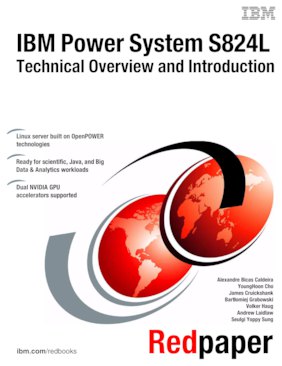Abstract
This IBM® Redpaper™ publication is a comprehensive guide that covers the IBM Power System S824L (8247-42L) server that supports the Linux operating systems. The objective of this paper is to introduce the major innovative Power S824L offerings and their relevant functions:
- The new IBM POWER8™ processor, which is available at frequencies of 3.02 GHz and 3.42 GHz
- Based on OpenPOWER technologies
- Two integrated memory controllers with improved latency and bandwidth
- Improved reliability, serviceability, and availability (RAS) functions
- IBM EnergyScale™ technology that provides features, such as power trending, power-saving, power capping, and thermal measurement
- A processor that is designed to accommodate high-wattage adapters, such as NVIDIA graphics processing units (GPUs), that provide acceleration for scientific, engineering, Java, big data analytics, and other technical computing workloads
This publication is for professionals who want to acquire a better understanding of IBM Power Systems™ products.
This paper expands the current set of IBM Power Systems documentation by providing a desktop reference that offers a detailed technical description of the Power S824L server.
This paper does not replace the latest marketing materials and configuration tools. It is intended as an additional source of information that, together with existing sources, can be used to enhance your knowledge of IBM server solutions.
Table of Contents
Chapter 1. General description
Chapter 2. Architecture and technical overview
Chapter 3. Reliability, availability, and serviceability
